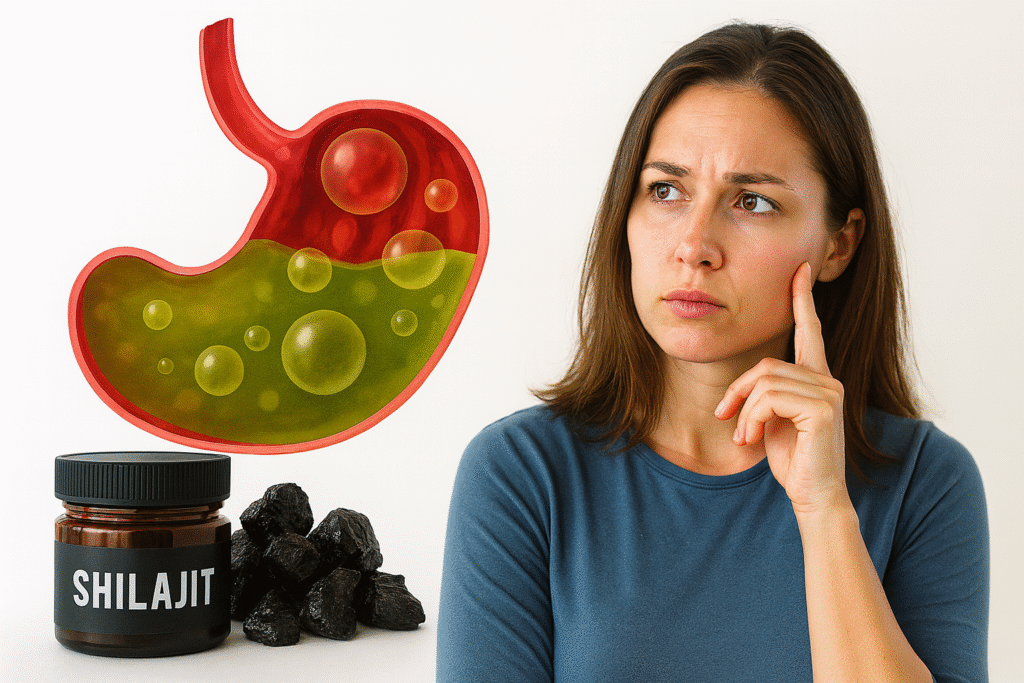If you’ve ever struggled with stomach discomfort recently while taking shilajit, you might have asked yourself, “Is shilajit good for gastritis?”
This question comes up often because Shilajit, a natural mineral-rich resin used in traditional Ayurvedic medicine, is well-known for boosting energy, improving immunity, and supporting overall wellness.
But when it comes to digestive health—especially conditions like gastritis, acid reflux, or gut irritation—the answer isn’t always straightforward.
Some people share positive experiences, saying Shilajit helped reduce bloating and gave them better digestive balance.
On the other hand, there are cases where it may worsen stomach irritation if taken incorrectly or in large amounts.
That’s why it’s important to look at both scientific research and traditional wisdom before deciding whether Shilajit and stomach health go hand in hand.
In this blog post, we’ll break down what gastritis is, how Shilajit interacts with the digestive system, potential benefits, possible side effects, and safe usage tips.
By the end, you’ll have a clear understanding of whether Shilajit is a good choice for managing gastritis or if you should explore other natural options.
Let’s Understand Gastritis
Before we explore whether Shilajit is good for gastritis, it’s important to clearly understand what gastritis actually is.
In simple words, gastritis means inflammation of the stomach lining. When the protective layer of your stomach gets irritated or damaged, the acid inside can cause pain, discomfort, and other unpleasant symptoms.
Types of Gastritis: Acute vs. Chronic
- Acute Gastritis – This type develops suddenly. For example, you might feel a sharp burning pain or nausea right after taking certain medicines like painkillers, drinking excess alcohol, or going through severe stress. This is sometimes temporary.
- Chronic Gastritis – This one builds up slowly over time. If left untreated, chronic gastritis can lead to ongoing stomach irritation, nutrient absorption problems, and, in rare cases, ulcers.
Common Causes of Gastritis
Doctors usually trace gastritis back to a few well-known factors:
- H. pylori infection – This is one of the leading causes. According to the World Health Organization (WHO), more than half of the global population carries Helicobacter pylori bacteria, which can weaken the stomach lining and trigger inflammation [WHO, 2020].
- NSAIDs (non-steroidal anti-inflammatory drugs) – Medications like ibuprofen or aspirin, when taken frequently, can irritate the stomach lining.
- Excess alcohol – Drinking too much can erode the stomach’s protective layer.
- Stress – High physical or emotional stress can worsen acid secretion and damage the stomach lining.
- Autoimmune factors – In some cases, the body mistakenly attacks its own stomach lining, leading to chronic inflammation.
Usual Symptoms of Gastritis
The symptoms of gastritis can be mild for some people and very uncomfortable for others. The most common ones include:
- A burning sensation or pain in the upper abdomen (especially after meals).
- Nausea or vomiting, sometimes with a sour taste.
- Bloating and fullness even after eating a small amount.
- Indigestion and occasional heartburn.
What is Shilajit?
Shilajit is a natural resin-like substance that comes from the cracks of rocks in the Himalayan mountains and other high-altitude regions. High altitude shilajit may have high potency.
It forms over centuries from the slow decomposition of nearby plants and minerals under heat and pressure.
Shilajit Composition
The power of Shilajit comes from its unique composition. It is packed with:
- Fulvic acid – a natural compound known for helping the body absorb nutrients more efficiently.
- Trace minerals – shilajit contains more than 80 trace minerals such as iron, magnesium, zinc, and copper, which play a key role in cellular energy and metabolic functions.
- Antioxidants – that may help protect cells from oxidative stress and support overall wellness.
This is why Shilajit is not just a random herbal extract but a nutrient-dense natural supplement.
Traditional Ayurvedic Use
In Ayurveda, Shilajit has been used for thousands of years as a rejuvenator (Rasayana). Traditionally, it was prescribed for:
- Boosting energy and stamina in your body
- Strengthening your immunity
- Improving the digestion and absorption of food in your body
- Balancing the body’s internal systems
Many Ayurvedic practitioners still consider it a natural remedy to support gut health, which is why the link between Shilajit and digestion often comes up in modern wellness discussions.
How much shilajit should I use per day?
Most health experts recommend taking 300–500 mg of purified Shilajit per day. It’s usually best to consume it in the morning or early afternoon with warm water or milk for better absorption.

However, always start with a smaller dose and consult a healthcare professional before long-term use, especially if you have digestive issues like gastritis.
Shilajit and Digestive Health
- Studies on Shilajit’s anti-inflammatory and antioxidant effects.
- Possible mechanisms relevant to gastritis:
- May reduce oxidative stress in the stomach lining.
- May support gut microbiome balance.
- May promote tissue repair.
Benefits of Shilajit for Gastritis
While Shilajit and its natural compounds suggest several ways it might support digestive wellness:
- Anti-inflammatory action – May help reduce irritation in the stomach lining.
- Rich in antioxidants – Could protect stomach cells from oxidative stress and damage.
- Supports nutrient absorption – Shilajit’s fulvic acid may improve how the body absorbs vitamins and minerals, often a problem in chronic gastritis.
- Balances stomach acid – Some practitioners suggest it may help normalize acid levels, easing discomfort.
- Gut microbiome support – Could encourage the growth of healthy gut bacteria.
- Promotes tissue repair – May aid the healing of minor damage to the stomach lining.
- Boosts energy and recovery – Helpful for people with gastritis who often feel fatigued.
- Supports immune response – May strengthen the body’s ability to fight infections like H. pylori.
- Stress resilience – Known as an adaptogen, Shilajit might help reduce stress, which is a common trigger for gastritis flare-ups.
- Holistic digestive aid – In traditional Ayurveda, it’s believed to enhance overall digestive fire (Agni), promoting better breakdown of food without excessive strain on the stomach.
Pro Tip: Always take Shilajit according to your dosha type—Vata, Pitta, or Kapha—because each body has a different natural temperature. Since Shilajit is inherently heating, it can increase internal heat if not taken as per your dosha.
Side Effects, Risks, and Precautions
- Shilajit is not clinically approved as a treatment for gastritis only.
- Possible side effects may include nausea, upset stomach, or allergic reactions in sensitive individuals.
- Unpurified or contaminated Shilajit can contain heavy metals or harmful compounds, so only trusted, purified products should be used.
- It may interact with certain medications, such as blood pressure drugs or diabetes medicines, so consultation with a healthcare professional is essential before use.
- Find out if Shilajit is real or fake just by doing this test.
Who Should Avoid Shilajit if They Have Gastritis?
- People experiencing severe or active gastritis flare-ups
- Those with ulcers, GERD, or highly sensitive stomachs
- Pregnant or breastfeeding women
- Anyone using non-purified or untested Shilajit products
Expert Opinions & Current Research Gaps
While Shilajit shows promise for stomach health based on lab and animal studies, the clinical evidence on gastritis remains sparse. Experts in integrative medicine urge caution:
What Science Tells Us:
- A 2021 study on rats found that aqueous Shilajit extract significantly reduced aspirin-induced gastric lesions, showing tissue-protective, antioxidant, and anti-inflammatory effects—comparable to omeprazole in healing capacity
Conclusion
Gastritis can be a frustrating condition, and many people look toward natural remedies for relief. The big question—is Shilajit good for gastritis?—doesn’t have a simple yes or no answer yet. But I will suggest not only taking shilajit for the gastritis problems because it helps with your overall health benefits.
Shilajit shows potential benefits such as reducing inflammation, protecting the stomach lining, and improving nutrient absorption.
However, because direct human studies on gastritis are limited, it should be seen as a supportive supplement rather than a primary treatment.
If you’re considering Shilajit for digestive wellness, always choose a purified, lab-tested product and consult a healthcare professional—especially if you already struggle with stomach issues or take medications.
Also Read: 10 People Who Should Avoid Shilajit Honey Sticks
FAQs
Can Shilajit cause constipation?
Not directly, but some people report mild digestive changes like constipation or loose stools, depending on dosage and purity.
Does Shilajit increase stomach acid?
There’s no strong evidence that it directly raises acid, but sensitive users may feel burning if taken on an empty stomach.
Is Shilajit safe to take with probiotics?
Generally, yes—but since both affect gut balance, it’s best to start slowly and monitor how your body reacts.
Can Shilajit affect iron levels in the body?
Yes, it naturally contains trace minerals like iron, so people with high iron levels should use it cautiously.
Should Shilajit be taken with food or on an empty stomach?
Most experts suggest taking it with food or warm milk/water to reduce stomach irritation.
How long does it take to notice effects from Shilajit?
Some users report energy or digestion changes within weeks, but benefits for chronic conditions usually take longer to assess.
References:
Shilajit: A Natural Phytocomplex with Potential Procognitive Activity
Disclaimer
This article is for informational purposes only. Please consult a licensed healthcare provider before starting any new supplement, especially if you are pregnant, breastfeeding, or on medication.



